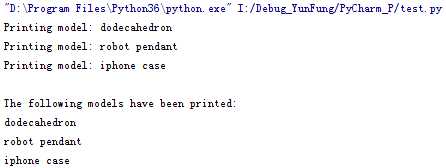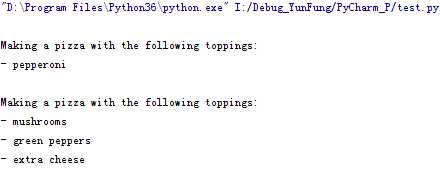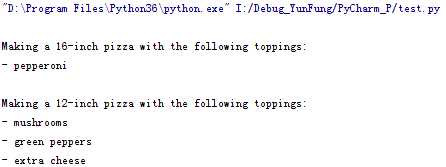Python学习笔记7_函 数
Posted
tags:
篇首语:本文由小常识网(cha138.com)小编为大家整理,主要介绍了Python学习笔记7_函 数相关的知识,希望对你有一定的参考价值。
1.1 定义函数
def greet_user(): """显示简单的问候语""" print("Hello!") #一个空格 print("World!") greet_user()

1.1.1 向函数传递信息
# username = "Hello Python world!" def greet_user(username): """显示简单的问候语""" print("Hello, " + username.title() + "!") greet_user("yunfung")

1.2 传递实参
1.2.1 位置实参
def describe_pet(animal_type, pet_name): """显示宠物的信息""" print("\\nI have a " + animal_type + ".") print("My " + animal_type + "‘s name is " + pet_name.title() + ".") describe_pet(‘hamster‘, ‘harry‘)

1.2.2 关键字实参
直接在实参中将名称和值关联起来了,因此向函数传递实参时不会混淆.
def describe_pet(animal_type, pet_name): """显示宠物的信息""" print("\\nI have a " + animal_type + ".") print("My " + animal_type + "‘s name is " + pet_name.title() + ".") describe_pet(animal_type=‘hamster‘, pet_name=‘harry‘)

1.2.3 默认值
编写函数时,可给每个形参指定默认值。在调用函数中给形参提供了实参时,Python将使用指定的实参值;否则,将使用形参的默认值。
例如,如果调用describe_pet()时,描述的大都是小狗,就可将形参animal_type的默认值设置为‘dog‘。这样,调用describe_pet()来描述小狗时,就可不提供这种信息:
def describe_pet(pet_name, animal_type=‘dog‘): """显示宠物的信息""" print("\\nI have a " + animal_type + ".") print("My " + animal_type + "‘s name is " + pet_name.title() + ".") describe_pet(pet_name=‘willie‘)

1.3 返回值
在函数中,可使用return语句将值返回到调用函数的代码行。
1.3.1 返回简单值
def get_formatted_name(first_name, last_name): """返回整洁的姓名""" full_name = first_name + ‘ ‘ + last_name return full_name.title() musician = get_formatted_name(‘jimi‘, ‘hendrix‘) #离开循环不需要空格 print(musician)

1.3.2 让实参变成可选的
有时候,需要让实参变成可选的,这样使用函数的人就只需在必要时才提供额外的信息。例如,假设我们要扩展函数get_formatted_name(),使其还处理中间名。
def get_formatted_name(first_name, last_name, middle_name=‘‘): """返回整洁的姓名""" if middle_name: full_name = first_name + ‘ ‘ + middle_name + ‘ ‘ + last_name else: full_name = first_name + ‘ ‘ + last_name return full_name.title() musician = get_formatted_name(‘jimi‘, ‘hendrix‘) print(musician)

1.3.3 返回字典
函数可返回任何类型的值,包括列表和字典等较复杂的数据结构。
def build_person(first_name, last_name): """返回一个字典,其中包含有关一个人的信息""" person = {‘first‘: first_name, ‘last‘: last_name} return person musician = build_person(‘jimi‘, ‘hendrix‘) print(musician)

在函数定义中,新增了一个可选形参age,并将其默认值设置为空字符串。如果函数调用中包含这个形参的值,这个值将存储到字典中。
def build_person(first_name, last_name, age=‘‘): """返回一个字典,其中包含有关一个人的信息""" person = {‘first‘: first_name, ‘last‘: last_name} if age: person[‘age‘] = age return person musician = build_person(‘jimi‘, ‘hendrix‘, age=27) print(musician)

1.3.4 结合使用函数和while 循环
def get_formatted_name(first_name, last_name): """返回整洁的姓名""" full_name = first_name + ‘ ‘ + last_name return full_name.title() # 这是一个无限循环! while True: print("\\nPlease tell me your name:") f_name = input("First name: ") l_name = input("Last name: ") formatted_name = get_formatted_name(f_name, l_name) print("\\nHello, " + formatted_name + "!")

1.4 传递列表
将greet_users()定义成接受一个名字列表,并将其存储在形参names中。这个函数遍历收到的列表,并对其中的每位用户都打印一条问候语。
def greet_users(names): """向列表中的每位用户都发出简单的问候""" for name in names: msg = "Hello, " + name.title() + "!" print(msg) usernames = [‘hannah‘, ‘ty‘, ‘margot‘] greet_users(usernames)

1.4.1 在函数中修改列表
需要打印的设计存储在一个列表中,打印后移到另一个列表中。下面是在不使用函数的情况下模拟这个过程的代码:
# 首先创建一个列表,其中包含一些要打印的设计 unprinted_designs = [‘iphone case‘, ‘robot pendant‘, ‘dodecahedron‘] completed_models = [] # 模拟打印每个设计,直到没有未打印的设计为止 # 打印每个设计后,都将其移到列表completed_models中 while unprinted_designs: current_design = unprinted_designs.pop() #模拟根据设计制作3D打印模型的过程 print("Printing model: " + current_design) completed_models.append(current_design) # 显示打印好的所有模型 print("\\nThe following models have been printed:") for completed_model in completed_models: print(completed_model)

程序首先创建一个需要打印的设计列表,还创建一个名为completed_models的空列表,每个设计打印都将移到这个列表中。只要列表unprinted_designs中还有设计,while循环就模拟打印设计的过程:从该列表末尾删除一个设计,将其存储到变量current_design中,并显示一条消息,指出正在打印当前的设计,再将该设计加入到列表completed_models中。循环结束后,显示已打印的所有设计:
为重新组织这些代码,我们可编写两个函数,每个都做一件具体的工作。大部分代码都与原来相同,只是效率更高。第一个函数将负责处理打印设计的工作,而第二个将概述打印了哪些设计:
def print_models(unprinted_designs, completed_models): """ 模拟打印每个设计,直到没有未打印的设计为止 打印每个设计后,都将其移到列表completed_models中 """ while unprinted_designs: current_design = unprinted_designs.pop() # 模拟根据设计制作3D打印模型的过程 print("Printing model: " + current_design) completed_models.append(current_design) def show_completed_models(completed_models): """显示打印好的所有模型""" print("\\nThe following models have been printed:") for completed_model in completed_models: print(completed_model) unprinted_designs = [‘iphone case‘, ‘robot pendant‘, ‘dodecahedron‘] completed_models = [] print_models(unprinted_designs, completed_models) show_completed_models(completed_models)
1.4.2 禁止函数修改列表
向函数传递列表的副本而不是原件;这样函数所做的任何修改都只影响副本,而丝毫不影响原件。
function_name(list_name[:])
切片表示法[:]创建列表的副本
print_models(unprinted_designs[:], completed_models)
虽然向函数传递列表的副本可保留原始列表的内容,但除非有充分的理由需要传递副本,否则还是应该将原始列表传递给函数,因为让函数使用现成列表可避免花时间和内存创建副本,从而提高效率,在处理大型列表时尤其如此。
1.5 传递任意数量的实参
Python允许函数从调用语句中收集任意数量的实参。
例如,来看一个制作比萨的函数,它需要接受很多配料,但你无法预先确定顾客要多少种配料。下面的函数只有一个形参*toppings,但不管调用语句提供了多少实参,这个形参都将它们统统收入囊中:
def make_pizza(*toppings): """打印顾客点的所有配料""" print(toppings) make_pizza(‘pepperoni‘) make_pizza(‘mushrooms‘, ‘green peppers‘, ‘extra cheese‘)

形参名*toppings中的星号让Python创建一个名为toppings的空元组,并将收到的所有值都封装到这个元组中。
def make_pizza(*toppings): """概述要制作的比萨""" print("\\nMaking a pizza with the following toppings:") for topping in toppings: print("- " + topping) make_pizza(‘pepperoni‘) make_pizza(‘mushrooms‘, ‘green peppers‘, ‘extra cheese‘)

1.5.1 结合使用位置实参和任意数量实参
如果要让函数接受不同类型的实参,必须在函数定义中将接纳任意数量实参的形参放在最后。Python先匹配位置实参和关键字实参,再将余下的实参都收集到最后一个形参中。例如,如果前面的函数还需要一个表示比萨尺寸的实参,必须将该形参放在形参*toppings的前面:
def make_pizza(size, *toppings): """概述要制作的比萨""" print("\\nMaking a " + str(size) + "-inch pizza with the following toppings:") for topping in toppings: print("- " + topping) make_pizza(16, ‘pepperoni‘) make_pizza(12, ‘mushrooms‘, ‘green peppers‘, ‘extra cheese‘)

1.5.2 使用任意数量的关键字实参
有时候,需要接受任意数量的实参,但预先不知道传递给函数的会是什么样的信息。在这种情况下,可将函数编写成能够接受任意数量的键—值对——调用语句提供了多少就接受多少。一个这样的示例是创建用户简介:你知道你将收到有关用户的信息,但不确定会是什么样的信息。在下面的示例中,函数build_profile()接受名和姓,同时还接受任意数量的关键字实参:
def build_profile(first, last, **user_info): """创建一个字典,其中包含我们知道的有关用户的一切""" profile = {} profile[‘first_name‘] = first profile[‘last_name‘] = last for key, value in user_info.items(): profile[key] = value return profile user_profile = build_profile(‘albert‘, ‘einstein‘,location=‘princeton‘,field=‘physics‘) print(user_profile)

函数build_profile()的定义要求提供名和姓,同时允许用户根据需要提供任意数量的名称—值对。形参**user_info中的两个星号让Python创建一个名为user_info的空字典,并将收到的所有名称—值对都封装到这个字典中。然后遍历字典user_info中的键—值对,并将每个键—值对都加入到字典profile中。
1.6 将函数存储在模块中
函数的优点之一是,使用它们可将代码块与主程序分离。通过给函数指定描述性名称,可让主程序容易理解得多。还可以更进一步,将函数存储在被称为模块的独立文件中,再将模块导入到主程序中。import语句允许在当前运行的程序文件中使用模块中的代码。
1.6.1 导入整个模块
模块是扩展名为.py的文件,包含要导入到程序中的代码。下面来创建一个包含函数make_pizza()的模块。
def make_pizza(size, *toppings): """概述要制作的比萨""" print("\\nMaking a " + str(size) + "-inch pizza with the following toppings:") for topping in toppings: print("- " + topping)
接下来,在pizza.py所在的目录中创建另一个名为making_pizzas.py的文件,这个文件导入刚创建的模块,再调用make_pizza()两次:

如果使用这种import语句导入了名为module_name.py的整个模块,就可使用下面的语法来使用其中任何一个函数:
module_name.function_name()
1.6.2 导入特定的函数
可以导入模块中的特定函数,这种导入方法的语法如下:
from module_name import function_name
通过用逗号分隔函数名,可根据需要从模块中导入任意数量的函数:
from module_name import function_0, function_1, function_2
对于前面的making_pizzas.py示例,如果只想导入要使用的函数,代码将类似于下面这样:
from pizza import make_pizza
make_pizza(16, ‘pepperoni‘)
make_pizza(12, ‘mushrooms‘, ‘green
peppers‘, ‘extra cheese‘)
1.6.3 使用as 给函数指定别名
如果要导入的函数的名称可能与程序中现有的名称冲突,或者函数的名称太长,可指定简短而独一无二的别名——函数的另一个名称,类似于外号。要给函数指定这种特殊外号,需要在导入它时这样做。
下面给函数make_pizza()指定了别名mp()。这是在import语句中使用make_pizza as mp实现的,关键字as将函数重命名为你提供的别名:
from pizza import make_pizza
as mp
mp(16,
‘pepperoni‘)
mp(12,
‘mushrooms‘, ‘green
peppers‘, ‘extra cheese‘)
1.6.4 使用as 给模块指定别名
同样可以给模块指定别名。
import pizza as p
p.make_pizza(16, ‘pepperoni‘)
p.make_pizza(12, ‘mushrooms‘, ‘green
peppers‘, ‘extra cheese‘)
1.6.5 导入模块中的所有函数
使用星号(*)运算符可让Python导入模块中的所有函数:
from pizza import *
make_pizza(16, ‘pepperoni‘)
make_pizza(12, ‘mushrooms‘,
‘green peppers‘, ‘extra
cheese‘)
import语句中的星号让Python将模块pizza中的每个函数都复制到这个程序文件中。由于导入了每个函数,可通过名称来调用每个函数,而无需使用句点表示法。然而,使用并非自己编写的大型模块时,最好不要采用这种导入方法:如果模块中有函数的名称与你的项目中使用的名称相同,可能导致意想不到的结果:Python可能遇到多个名称相同的函数或变量,进而覆盖函数,而不是分别导入所有的函数。
1.7 函数编写指南
编写函数时,需要牢记几个细节。
- 应给函数指定描述性名称,且只在其中使用小写字母和下划线。描述性名称可帮助你和别人明白代码想要做什么。给模块命名时也应遵循上述约定。
- 每个函数都应包含简要地阐述其功能的注释,该注释应紧跟在函数定义后面,并采用文档字符串格式。文档良好的函数让其他程序员只需阅读文档字符串中的描述就能够使用它
- 给形参指定默认值时,等号两边不要有空格:
def function_name(parameter_0, parameter_1=‘default value‘)
- 对于函数调用中的关键字实参,也应遵循这种约定:
function_name(value_0, parameter_1=‘value‘)
- PEP 8(https://www.python.org/dev/peps/pep-0008/)建议代码行的长度不要超过79字符,这样只要编辑器窗口适中,就能看到整行代码。如果形参很多,导致函数定义的长度超过了79字符,可在函数定义中输入左括号后按回车键,并在下一行按两次Tab键,从而将形参列表和只缩进一层的函数体区分开来。
def function_name(
parameter_0, parameter_1, parameter_2,
parameter_3, parameter_4, parameter_5):
function body...
以上是关于Python学习笔记7_函 数的主要内容,如果未能解决你的问题,请参考以下文章